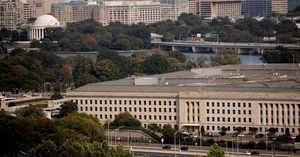Bank of America (BAC) has been ordered to pay $540.3 million to the Federal Deposit Insurance Corporation (FDIC) in a ruling that caps a lengthy legal battle over underpaid deposit insurance fees. U.S. District Judge Loren AliKhan delivered the verdict, which relates to assessments from the second quarter of 2013 through the fourth quarter of 2014, in a decision made public on April 14, 2025.
The penalty is part of a larger dispute that began in 2017 when the FDIC sued Bank of America, claiming the bank had failed to pay a total of $1.12 billion in deposit insurance assessments. The lawsuit accused the bank of skirting a 2011 rule that required banks to report their risk exposure to counterparties in a more standardized manner, thereby affecting how they calculated their deposit insurance contributions.
In her ruling, Judge AliKhan stated, "the law is not on [Bank of America’s] side," affirming the bank's liability for the unpaid assessments. The judge dismissed Bank of America's arguments that the FDIC’s rule was arbitrary or lacked a reasonable basis, emphasizing the regulatory agency's authority to ensure banking stability in the aftermath of the 2008 financial crisis. However, the court found that claims made before mid-2013 were untimely.
Despite this setback, Bank of America reported robust financial results for the first quarter of 2025, posting earnings of 90 cents per share and revenue of $27.51 billion. This performance included an 11% profit increase to $7.4 billion, driven by a significant boost in net interest income, which reached $14.6 billion. The bank also saw a 17% rise in equities trading revenue, totaling $2.2 billion, and a 5% increase in fixed income revenue, which amounted to $3.5 billion. However, investment banking fees dipped by 3% to $1.5 billion.
Bank of America’s CFO, Alastair Borthwick, acknowledged during the bank's earnings call that litigation costs were higher due to the recent ruling. The bank's non-interest expenses for the first quarter totaled $17.8 billion, reflecting a 6% increase, or $1 billion, compared to the previous quarter. Borthwick also noted the bank's acquisition of an $8 billion portfolio of residential mortgage loans, which is expected to generate an additional $100 million in net interest income annually.
Despite a 16.5% decline in the bank's stock year-to-date, attributed to recession fears, the $1.5 billion provision for loan losses was better than anticipated, showcasing the bank's financial resilience. This strength positions Bank of America to absorb the FDIC penalty while navigating ongoing economic uncertainties.
The FDIC, established in 1933 during the Great Depression, is tasked with insuring deposits at U.S. member banks, ensuring customer safety in the event of bank failures. The agency has been increasing deposit insurance contributions from the largest U.S. banks since the 2008 financial crisis, which left the deposit fund significantly depleted.
In 2011, the FDIC revised its rules to eliminate practices that allowed banks to minimize their assessments by reporting lower levels of counterparty risk. The rule mandated that banks report risk exposure at a consolidated entity level rather than individually. Bank of America contended that its payments were based on a technical disagreement regarding the calculation methods following the rule change, denying any intention to evade payments.
During the court proceedings, the FDIC accused Bank of America of making false or fraudulent statements about its counterparty exposures, which allegedly prevented the agency from discovering the bank's errors until a 2016 audit. The bank has consistently denied any intention to evade, emphasizing that it had kept the FDIC informed about its reporting methods.
Judge AliKhan acknowledged the bank's disclosures about its reporting practices, stating, "the court is hard-pressed to understand how its actions indicate an intent to evade." However, she upheld the validity of the FDIC's rule, indicating that Bank of America should have been able to identify the standards it was expected to follow with "ascertainable certainty."
As the bank navigates this legal landscape, CEO Brian Moynihan and CFO Alastair Borthwick have both expressed confidence in Bank of America’s ability to manage its credit risk profile amidst growing recession predictions fueled by tariff volatility and trade war concerns. Moynihan stated, "We’ve been working hard to ensure that the bank can serve our clients well and not have to be pulling back," highlighting the bank's efforts to cultivate a more balanced and less risky loan portfolio.
Overall, while the ruling presents a significant financial obligation for Bank of America, its strong quarterly performance suggests that the bank is well-positioned to handle the challenges ahead, including the FDIC penalty and the broader economic landscape.






